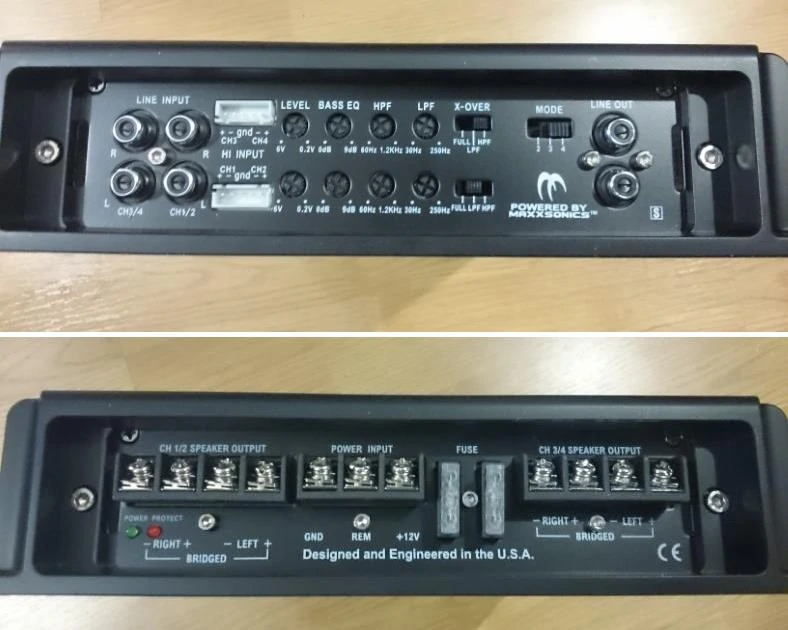カー アンプの役割必要な唯一のガイド
カーアンプがどのように機能し、何に使用されているのか疑問に思っていますか?アップグレードしたいカーオーディオシステムをアップグレードする準備はできていますが、最初に詳細を知る必要がありますか? あなたは正しい場所に来ました!
あなたが知る必要があるすべてをカバーします:
- カーオーディオアンプの仕組み
- その機能とサウンドに役立つ理由
- さまざまなオーディオ アンプ クラスの違い
…そしてもっともっと!
カーアンプは何をしますか?
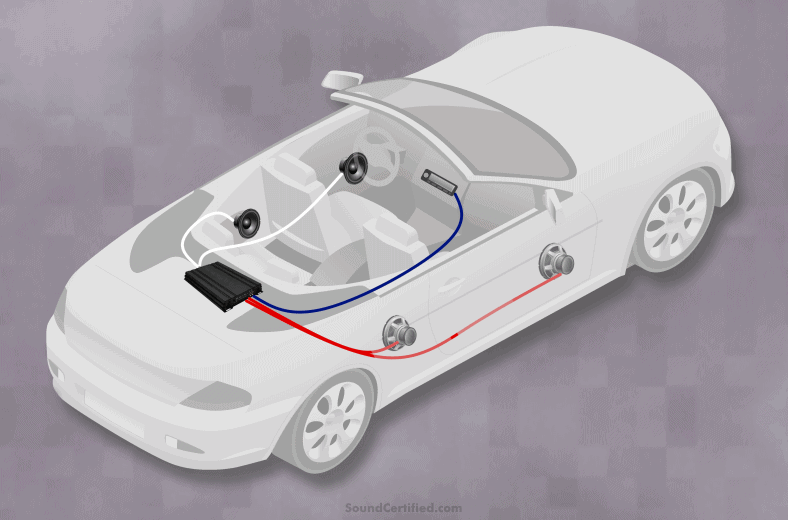
カー アンプは、ヘッド ユニットからの非常に小さな電気オーディオ信号をより高い電圧にブーストします。スピーカー ワイヤーに接続されたラウドスピーカーを、より大きなパワー、音量、明瞭な音で駆動できます。 ほとんどのカー オーディオ インダッシュ ステレオは、約 15 ~ 18 ワットしか利用できず、最大出力でひどく歪み始めます。
外部アンプはこの問題を解決するだけでなく、楽しむ音楽の再生忠実度を大幅に向上させることができます.
強力な低音を得るには、サブウーファーに多くのパワーが必要ですが、これはカー ステレオだけでは得られません。これは、サウンド システムをアップグレードする際に最大のパフォーマンスを得るために、より多くの電力を必要とする 4 Ω または 2 Ω のアフターマーケット スピーカーを使用する場合にも問題になります。
外部アンプは、その目的のために含まれるより高度な電子機器により、ノイズと歪みを低減できるため、より高い音質を提供します。多くの場合、カー ステレオはより基本的な設計と安価なコンポーネントを使用するため、聞こえる音が制限されます。
アンプの電力定格の説明
連続または RMS ワット定格は、アンプが現実的に確実に提供できる出力を表します。 印象的に聞こえますが、「ピーク」または「最大」の電力仕様は専門的なものであり、通常の使用で得られるものではありません.
RMS パワーは、二乗平均平方根を指します 音響電子工学で使用されるような交流 (AC) 信号を記述するために電気工学で使用される測定値。 AC 電圧は直流 (DC) とは異なるため、計算は少し異なります。 RMS 測定ではこれが考慮されます。

購入者がより正確な情報を入手できるようにするために、Consumer Electronics Association (CEA) 2006 規格が作成され、正確な仕様の提供が奨励されています。 CEA-2006 仕様を記載した販売製品は、メーカーが宣伝しているものを提供することを実証しています。
カーアンプはどのように機能しますか?
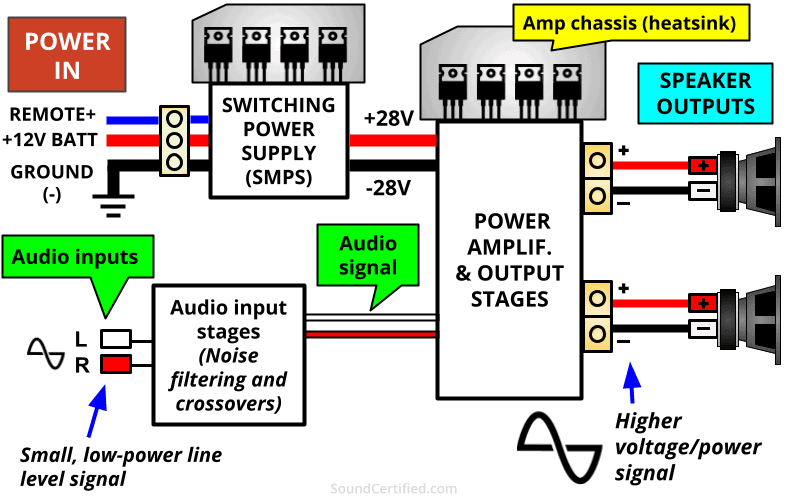
バッテリーの正と負の電源配線によって供給される内部電源は、12 ボルト電源から可能であるよりも高い出力電圧とより多くの電力を生成します。大きなアンプが描かれているため、ほとんどの場合、太いゲージの電源線とアース線が車両のバッテリーと金属シャーシに直接接続されています。
カー ステレオは、RCA ケーブルまたはその他の接続を介してオーディオ信号を送信します。この接続では、ブーストされた電気信号がスピーカー端子に送られ、ワイヤーで使用されます。
ほぼすべてのアフターマーケット カー オーディオ パワー アンプには、次のものがあります。
<オール>カーアンプの電源の説明
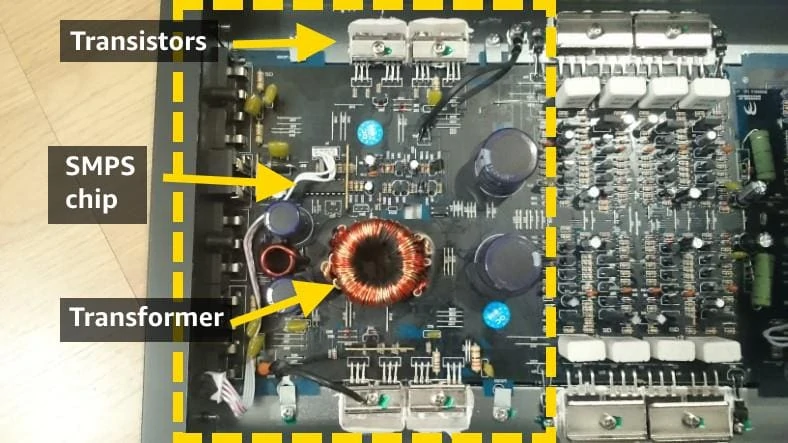
カーオーディオは非常に難しい課題を抱えています。+12V の電源しか使用していないため、工場出荷時のスピーカーとアップグレードされたスピーカーの両方に使用する大電力出力を直接生成することはできません。
これをよりよく理解するために、電力は負荷の抵抗 (スピーカーのインピーダンス) と電源電圧に関連しているというオームの法則を見ることができます。より多くの電力を得るには、負荷抵抗を下げるか、電圧を上げる必要があります。
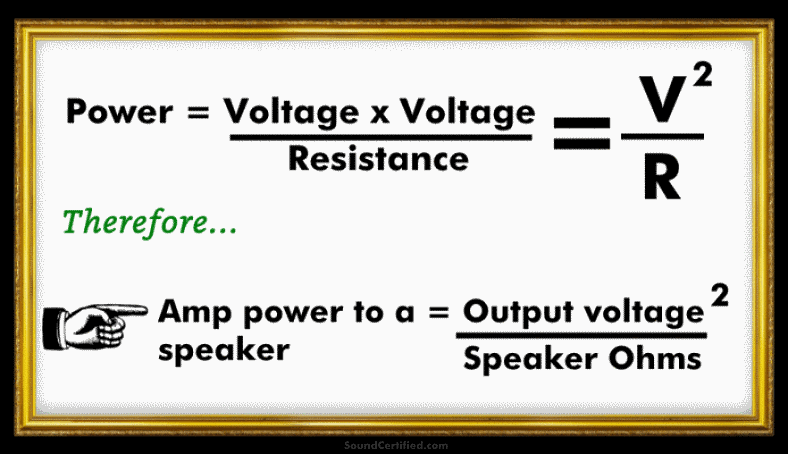
オームの法則は、負荷に供給される電力を計算するために使用される一連の数式です。より多くの電力を得るには、(1) オーム負荷 (インピーダンス) を下げるか、(2) 利用可能な電圧を上げる必要があります。
内部のスイッチモード電源 (SMPS) は、+12V のバッテリ電源を取り、たとえば約 28 ボルトから 32 ボルトまで数倍に増加させるため、これを可能にします。正極性と負極性の両方の供給経路も提供されます (供給「レール」とも呼ばれます)。
スイッチング集積回路 (IC) チップは、トランスに接続された高電流トランジスタを毎秒数千回オン/オフします。変圧器は、銅線の巻き数に基づいて、出力でより高い電圧を生成します。これらは、スピーカー チャンネルの電源を生成するために平滑化および安定化されます。
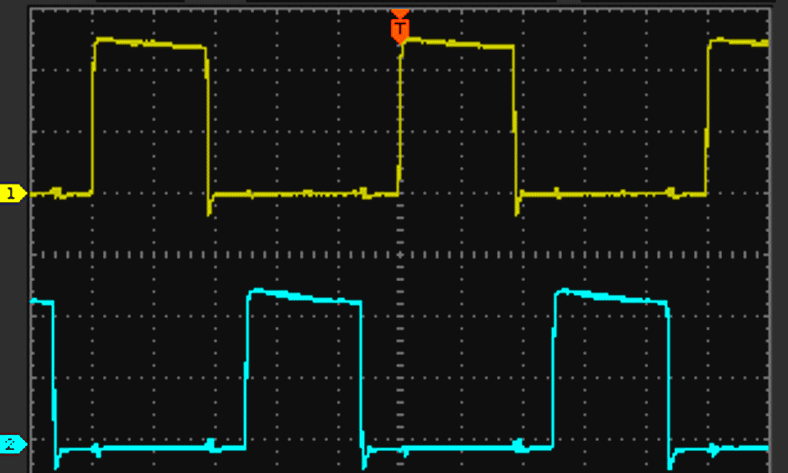
SMPS 電源内のトランジスタを毎秒数千回駆動するために使用される代替波形 (オン/オフ電圧信号) のスナップショット
カーアンプの DC-DC スイッチング電源は、ステップアップと呼ばれます。 彼らはより低い電圧を取り、それを数倍にしてより高い電圧にすることができるからです.降圧電源はその逆です。高出力スイッチング トランジスタなどの一部のコンポーネントは、発生した余分な熱を除去して放散するために、アンプの重金属シャーシに取り付けられています。そうしないと、熱による破壊により、最終的に失敗します。
アンプのオンとオフの仕組み
「リモート」ワイヤと呼ばれる低電流信号 (多くの場合 0.025 アンペア未満) を使用して、使用していないときにアンプがオンのままになり、バッテリーが消耗するのを防ぎます。リモートワイヤは、カーステレオまたはイグニッション配線の出力に接続されています。 +12V 信号が取り除かれると、アンプはオフになり、バッテリー電力の消費を停止します。
入力段、増幅部、出力段
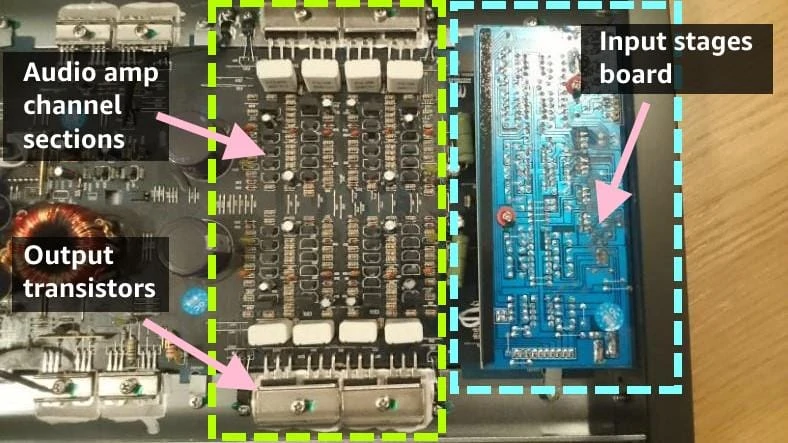
優れたカーオーディオを実現する 2 つのセクション、アンプ &出力セクションと入力ステージを示します。入力段ボードは、クロスオーバー機能の提供、より多くの電力を可能にするブリッジングの実現、ゲイン制御の提供、グランド ループ ノイズのブロックなどを行うための多くの小さな回路で構成されています。アンプ ステージは、入力ステージ ボードからオーディオ信号を受け取り、電源の出力を使用してブーストし、強力な出力を作成します。
入力段階
入力ステージには、実行する多くのジョブがあります:
- RCA ジャックのないステレオにアンプを接続できるようにする (提供されている場合はスピーカー レベルの入力)
- グラウンド ループ ノイズが信号経路に入らないようにする
- クロスオーバー機能を提供する
- アンプのゲイン レベルを調整できるようにする
入力段には、オペアンプ(オペアンプ)と呼ばれる非常に用途の広い電子部品が使用されています。オペアンプは、あらゆる種類のオーディオ機能に使用される小型チップに組み込まれた小さな増幅回路です。
騒音防止
グラウンド ループ ノイズは、カー オーディオの設置でよくある非常にイライラする問題です。 オルタネーターの鳴き声とも呼ばれます 、これは音声信号経路内の低レベルの電気ノイズの一種で、エンジン速度に応じて増減する恐ろしいうなり声として現れます。
このタイプのノイズは、車両のボディ内を流れる電流とオーディオ コンポーネントの接続によるものです。システム内の 2 点以上に電位差がある場合、わずかな電圧差が生じて増幅されます。これは、スピーカーから聞こえる甲高い迷惑な鳴き声として表示されます。
差動増幅器と呼ばれるフィルタ設計 回路はフロントエンド (入力側) で使用され、このノイズが音楽信号経路に入る前に効果的にブロックしてキャンセルします。
クロスオーバー
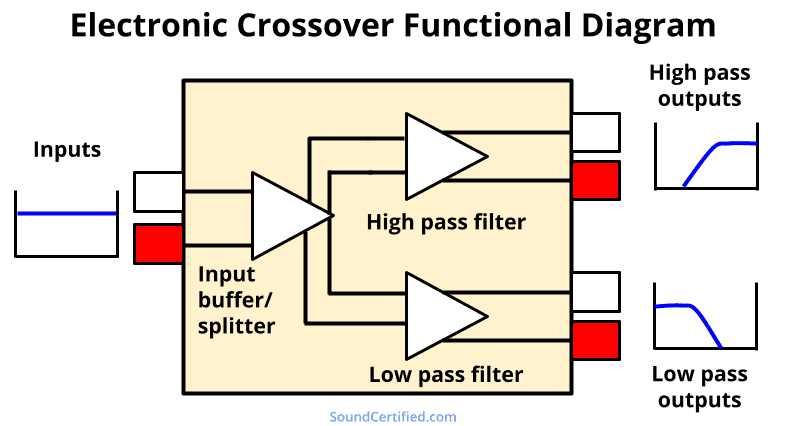
電子クロスオーバーは、車のスピーカーに送られる周波数範囲を制御する方法を提供します。たとえば、サブウーファーを駆動する場合、ローパス フィルターは低音以外のすべてをブロックして、優れた低音サウンドを提供します。同様に、ハイパス クロスオーバーを使用することで、ツイーターやドア スピーカーなどの小型スピーカーによる低音の歪みを防ぐことができます。
クロスオーバーを正しく使用すると、音量を上げ、スピーカーを保護し、より明瞭なサウンドを提供できます。コンポーネント スピーカーを使用するようなより高度なシステムでは、特に役立ちます。
アンプの電子クロスオーバーは、パッシブ スピーカーのクロスオーバーと同じ機能を果たしますが、必要なインダクターやコンデンサーなどのかさばるコンポーネントは必要ありません。また、スイッチのフリックで簡単に調整したり、オン/オフしたりできます。
アンプゲイン
名前が示すように、アンプはステレオからの入力信号をブーストします。さまざまなカー ステレオで使用される標準出力電圧がないため、音質、十分な電力、クリッピングと呼ばれる歪みの防止など、最良の結果を得るにはゲイン調整が必要です。
アンプのゲイン調整は、入力信号レベルに基づいて出力レベルを制御する方法を提供します。一部のカー ステレオはより強い出力信号を持っているため、出力レベルと音量に合わせてゲイン コントロールを下げることができます。
ゲインレベルはヘッドルームに影響します これは、制限に達する前に利用可能な増幅の量です。カーステレオからホームステレオ、さらにはホーム DJ 機器まで、すべてのタイプにゲイン調整が含まれていることがよくあります。
ノイズを減らす方法でもあります。 Because as all amps add some level of noise (like a “hiss” or similar) to their outputs, lowering the gain also reduces the noise produced and heard.
Amplifier sections and output stages
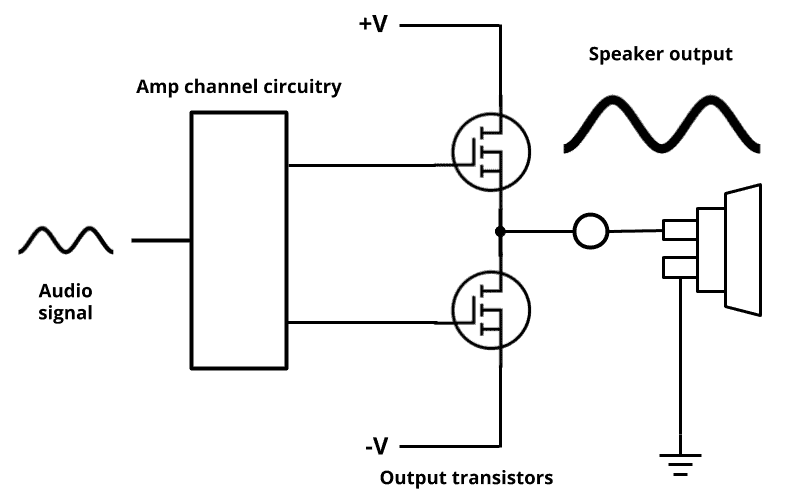
Simplified illustration of the amplification stages and output that most car amps use. Beefy output transistors capable of handling large amounts of current are connected to the switching power supply and drive the speaker. They’re controlled by some smaller components needed to split the audio signal into positive and negative halves needed to reproduce the musical signal.
Power amplifiers (as seen in the image above) have main sections dedicated to modify or manipulate audio signals as well as for delivering more current and voltage. The first sections contain small components like miniature transistors that divide the audio signal into two halves.
Next, after passing through the crossover filter and other stages, they’re directed to large high current transistors supplied with higher volts from the SMPS. The input signal is magnified to an identical but much larger waveform connect to the speaker outputs.
Car audio amplifier classes explained
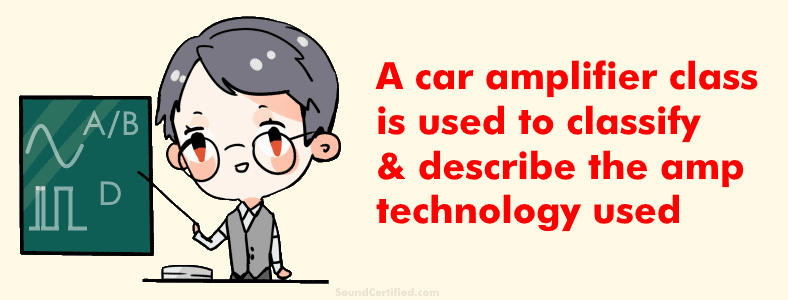
The class listed by a car audio amplifier manufacturer is the type of technology used for the audio signal and to deliver power. Every audio amp uses a class A, class D, or class A/B design.
- Class A: The most inefficient but provides audiophile quality sound. (Used in some past designs like from Rockford Fosgate)
- Class A/B: Until recently the most popular because they offer reasonable cost and good sound quality. Class A/B amps work similar to class A but switch off when the signal reaches the zero voltage threshold, reducing power consumed slightly.
- Class D: These amps are increasingly more common as they use newer technology to rapidly switch the power circuitry on and off, reducing waste and heat. Sometimes mistakenly called a “digital amplifier” although they don’t use digital technology for their basic functions.
Class D vs class A/B differences
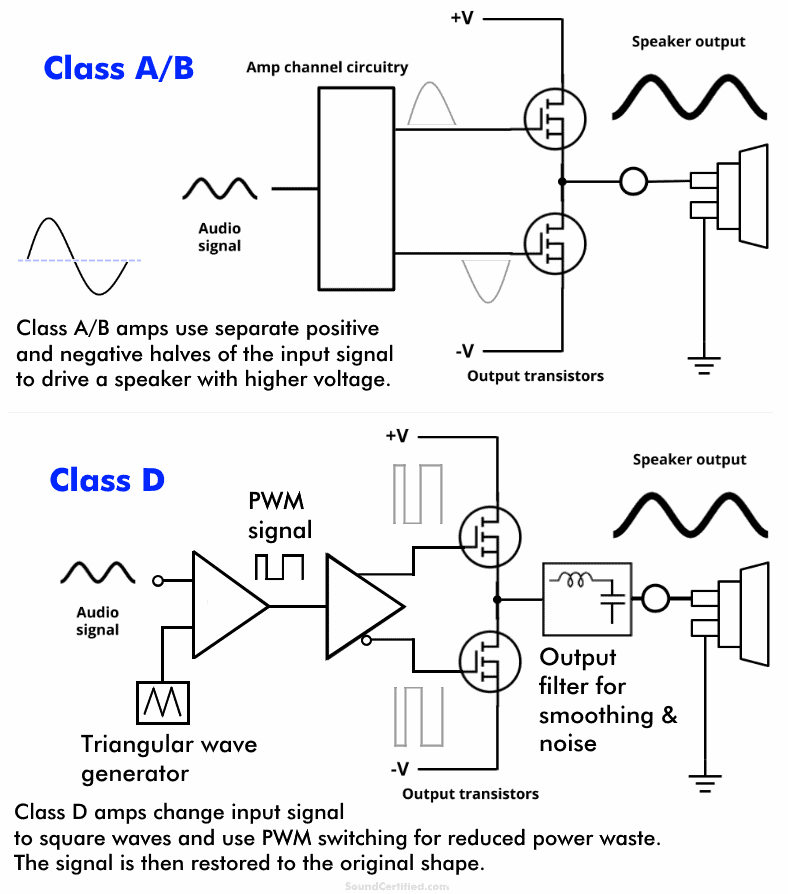
Class A/B designs conduct, follow, and amplify the analog input signal most of the time, using some power even when nothing is being delivered to the speakers. This is because even when you’re not driving speakers some power is wasted as heat due to losses. That’s one reason this type gets fairly warm especially during hard use.
They have an efficiency somewhere around 65% meaning they draw about 35% higher amps from the battery than is delivered as power to speakers. This is wasted purely as heat!
By contrast, a class D amp uses pulse width modulation (PWM) technology that switches power components on only a portion of the time . Unlike class A/B amps they convert the input signal to square waves used to control the on/off timing. These are converted back to smooth audio signal waves before being delivered to speakers.
Class D amplifier models are about 85% efficient meaning they run cooler and can be much smaller than A/B designs. As they offer more power in less, they’re really common for very high power subwoofer amplifier (mono amp) models sold today.
Class A/B amps offer lower noise levels for less money, although today’s D models have caught up fairly well especially for brand name designs.
What are channels on an amp?
Channels are independent audio paths that are used to create a sound output from an amplifier. In stereo recordings, the left and right audio sources differ and provide left vs. right audio sound.
In car audio, left and right audio channels are separate outputs from a car stereo or an independent signal path with an amplified output. They’re used to give a fuller, more realistic sound when listening. Additionally, some stereos provide front and rear outputs pairs, although these are simply the same signals provided to drive an extra pair of speakers in the rear.
In many cases stereo amplifier channels can be “bridged.” This means that 2 channels can work together in a push-pull fashion to speakers with more power than one channel alone (usually about twice the power of a single speaker output).
Car audio amp connections, inputs, and controls
Most car amplifiers, whether expensive or budget-priced, are very similar in how they’re designed. Generally power connections are located on one end and audio inputs and controls are found on the other end.
In image above you can see adjustable crossover dials and the switches to enable them. The point after which sound frequencies are blocked, called the cutoff frequency , is adjustable by the user with a small dial in some cases. In other models, it’s a fixed setting operated with a switch and can’t be changed.
However, fixed crossover frequencies are normally set to the most commonly used values for convenience.
Power connections

Power and speaker connection terminals on a Pioneer GM-D9605 car amplifier.
Power connections are typically made using larger-gauge copper wire and connectors, often included in an amp wiring kit. RCA cables are used to connect the amplifier to the audio signal outputs of the head unit from which music is played.
Note that to bridge 2 channels on the amp and deliver more power as a single channel, they’re connected in a particular way. The bottom image above shows the polarity and wiring connections required. They’re marked as “Bridged” as you can see.
In bridged mode, one channel provides the positive speaker connection and the other provides the negative.
Speaker level inputs
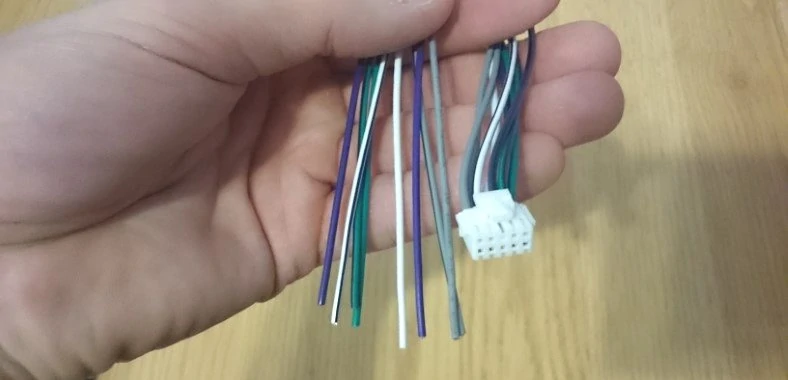
A speaker level input wiring harness is shown. Speaker outputs from a factory stereo can be connected to the wiring then plugged into an amp to provide a signal when RCA jacks aren’t available.
Upgrading a factory installed car audio system can be challenging as RCA jacks aren’t usually available. In that case speaker-level (also called “high level”) inputs, if available, can be used to avoid buying additional parts.
These take the higher voltage speaker level signal directly from speaker wiring and reduce it to a smaller level the amplifier can use.
The other option is to use a speaker-level adapter to do the same thing.
How are car power amps installed?
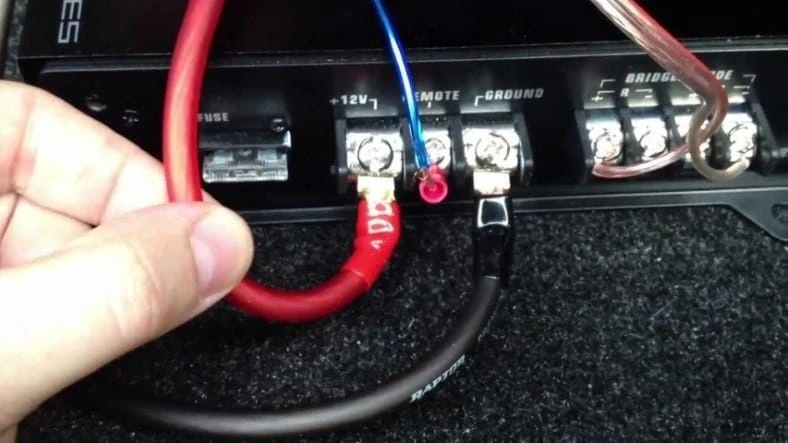
A typical installation for a car amplifier. Large-gauge power wires are connected to the power terminals and fastened using screws. Speaker wiring is connected similarly. After installation, the sound system is tested and the amp’s gain control and crossovers are adjusted as needed.
In order to work properly, car amplifiers have to be installed with sufficient size and type of power wire. The most important reason for this is because a vehicle’s original wiring cannot handle the high-current demands of an amplifier.
For example, some may draw 50 to 80 amps or more or when driving subwoofers very hard. Factory wiring isn’t rated for these kinds of demands and a loss of voltage (and consequently, power) to the amplifier would occur. Therefore we route a large enough power cable to the battery and make sure a good, clean electrical connection is made.
A sufficiently rated fuse, held in a fuse holder, protects the positive power cable. If a problem like a short circuit occurs the fuse would blow and protect against causing a fire.
There are several wiring connections used on all car amplifiers:
<オール>Fortunately, this wiring is often easily found pre-packaged and ready for use by buying an amplifier wiring kit.
Car amplifier installation diagram
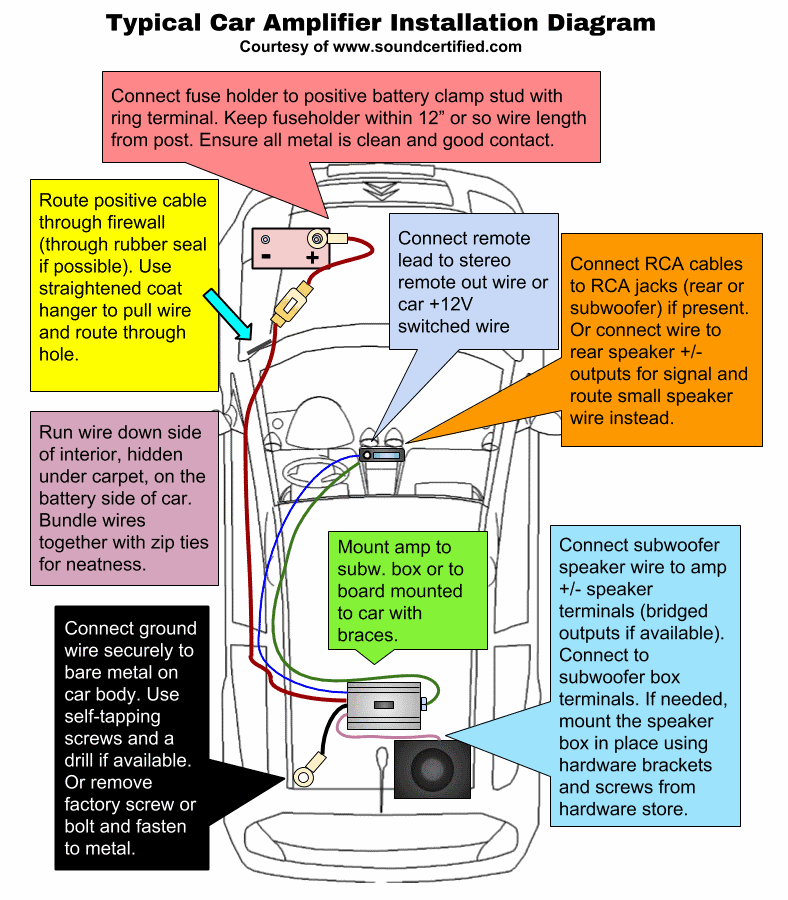
How are car amplifiers helpful?
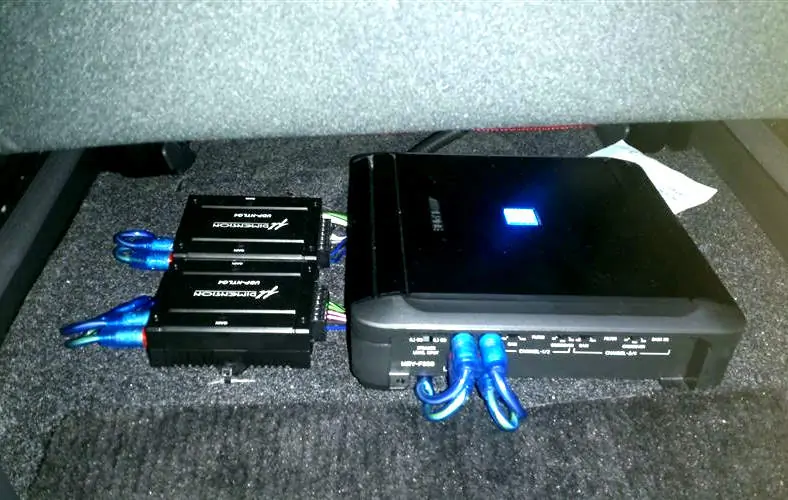
Today’s amplifiers can power a whole car audio system with excellent sound quality and volume. Some are very compact and can be installed under a seat or even inside your dashboard! A good amplifier provides several times the power output of an average car stereo. Also, they’re much more clear and crisp sounding.
Car amplifiers have many benefits as well as being a necessity in some cases. Typical car stereos, even today, can only produce about 15 to 18 watts of power per channel at most.
At higher volumes and when attempting to drive speakers that need more power, the sound from a stereo becomes distorted and terrible. Driving speakers with higher volume is basically impossible with only a car stereo.
Car amps offer much better sound, especially for bass-heavy music. There are also some special situations where they’re the only option for upgrading the sound in a vehicle:
- Factory stereo systems with no woofer
- Factory-installed amplifiers that have died or are weak
- The desire for powerful, clear sound when enjoying higher-quality music
- Vehicle owners who want heavy volume
- Boat and other outdoor vehicle owners (outdoor vehicles need extra power for better sound)
Additional benefits
As I mentioned earlier, many offer features like built-in crossovers that can prevent distortion and allow you to play speakers at higher volumes with enhanced clarity. Factory systems normally can’t do this and the sound will “break up” early when turned up to higher volumes.
Installing an aftermarket amplifier resolves this problem and allows more control over your audio system. Additionally, a system can easily be expanded to add a subwoofer for missing bass by either adding a 2nd amplifier or using 2 channels of a 4 channel amp to drive it.
2 channel vs 4 channel amps – what are the differences?
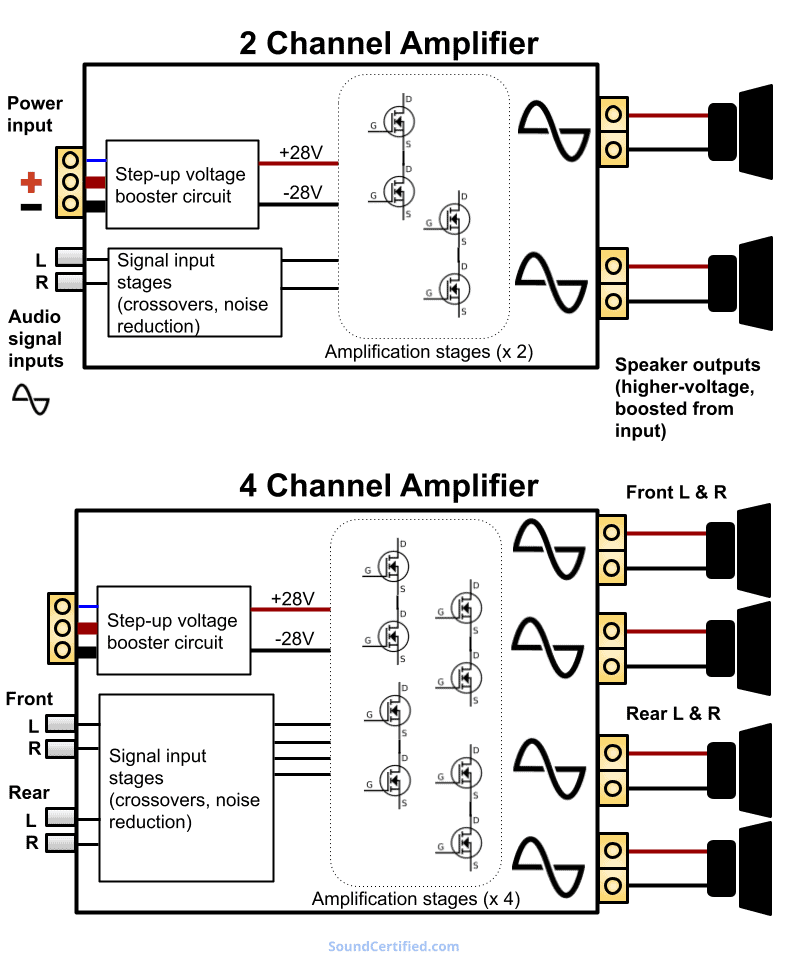
4 channel amplifiers are essentially a 2 channel amp with an additional stereo channel pair designed in. They offer several benefits:
- You can drive front and rear speakers
- Can drive front full-range speakers and use rear channels for a subwoofer
- More compact than 2 separate stereo amps
Most 4 channel amplifiers today are bridgeable so they’re very flexible in how they can be used. However, be aware that a 2 or 4 channel amp normally requires a minimum of 4 ohms when bridged unlike stereo mode.
More great car stereo and amp articles
- Got dual voice coil woofers? Here’s the best way to hook up an amp and subs.
- Learn how to connect and power a car amp in your home.
- Learn more details about what a class D amplifier is.
- See my helpful guide on how to bridge an amplifier.
- Check out my guide on how to hook up an amp to front and rear speakers.

